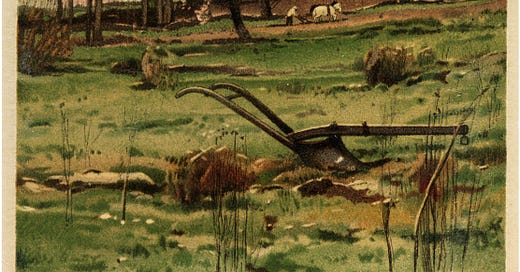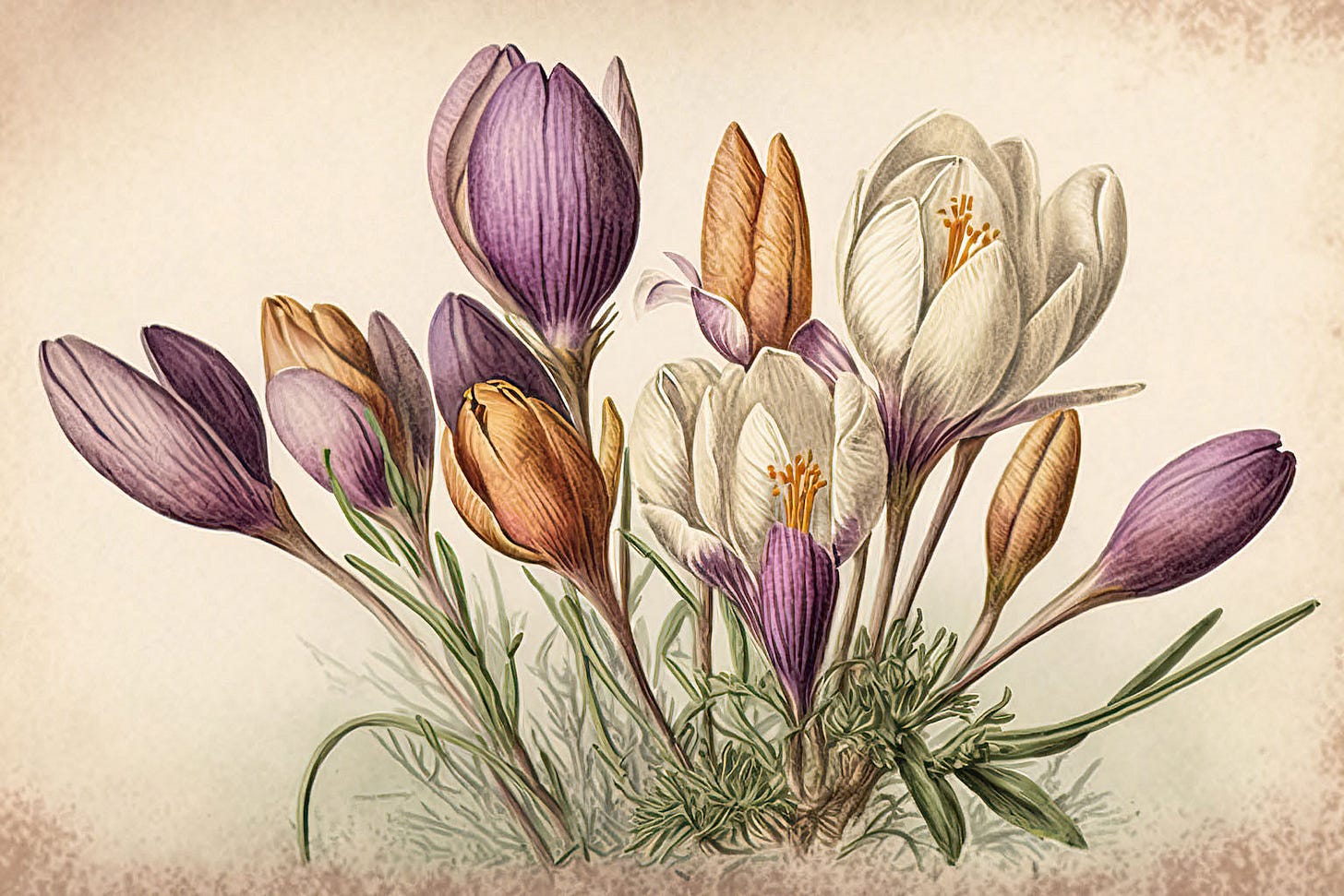From the editor
We find ourselves at a poignant shift in the Christian calendar, turning from the Christmas cycle (which stretched all the way through Candlemas on February 2) toward the Paschal1/Easter cycle. And, of all the times to enter into Lent - the anticipatory, penitential season that draws us to Easter - it lands on the feast of St. Valentine this year!
In Lent, we move from the celebration of Jesus’ birth to the remembrance of his crucifixion. It’s illuminating to note that we’re likewise moving from holy days formed in a solar pattern (Christmas is placed near the Winter Solstice) to holy days formed by both a solar and a lunar pattern (Easter falls on the first Sunday after the first full moon that follows the Spring Equinox).
That’s a mouthful, isn’t it? But, especially to our ancient brothers & sisters in the Church, the timing of these feasts was crucial - calendars and timekeeping were holy pursuits, and spoke of incarnational realities. They used the sun to tell the story of Christ’s birth, and the sun & the bright spring moon to amplify the story of his salvific work. Flowers are budding and leaves are unfurling, and it can seem incongruous with the penitential nature of Lent; our forebears, though, used the terms “Lent” and “Spring” synonymously, and there’s wisdom in that intersection.2
And so, though it might feel like Lent has snuck up on us early this year, the timing of Easter & its preamble of the Lenten season is part of a carefully-crafted, harmonious retelling. In it, we find the sun & the moon & all of the mysterious, glorious work Christ has humbly, sacrificially delivered to us and for us.
In this month’s issue of Signs + Seasons, we’re encountering a myriad of inspiring perspectives on Lenten themes. We’re also looking back to Candlemas from the start of the month (even after a holiday has passed, I like to keep bookmarks of gems that I’ve found along the way for next year).
I’m so thankful for all the voices behind the articles below, calling me back to a wider perspective on Lent, while also helping me to re-focus my attention outside of my own habits and inclinations. It’s a joy to get to enter into this season with you all!
Pax vobis,
Candlemas
Looking back to February 2
The Snowdrop, in purest white array, / First rears her head on Candlemas Day
| S+S EDITOR |
As we pivot to Spring, the feast of Candlemas on February 2 bears the story of the infant Christ’s presentation in the Temple and the affirmations of Simeon & Anna in response. Their years of faithful anticipation give way to joyful recognition - a childlike, springtime delight. How fitting that we would celebrate this moment in Christ’s life as we enter into a new season!
Read Kristin’s reflection here!
Lumen Ad Revelationem Gentium: A Candlemas Antiphon
shares her thoughtful reflection on a Candlemas antiphon, and just thinking about the theology infused in music makes my heart sigh with delight:My Gregorian Chant professor once pointed out that this notation pattern is a common stylistic tendency in Gregorian Chant; the notes will soar higher when referring to the divine and descend lower when referring to created beings. In many chants, this distinction is even more evident than in this Candlemas antiphon, but it nonetheless assists our understanding of the passage being chanted. When we hear this antiphon, we are listening to the Word of God being chanted, and the notation is designed to aid in our meditation upon the passage. In the case of this Candlemas antiphon, the chant helps us recall Christ’s glory as He came to illuminate the darkness of the world, taking on the lowliness of human flesh in order to redeem mankind from the bonds of sin and death.
Read more, and listen to a beautiful recording of this antiphon, here.
In Looking Forward
provides a fascinating glimpse into the historic attention given to weather prediction as the year turned from winter to spring; from weather-lore surrounding the Feast of the Purification (Candlemas) itself, to the Germanic Badger Day, to Groundhog Day (a modern remnant of Candlemas here in America) - all these traditions on February 2 are saturated with concern about the weather:Whether hearing, “if Candlemas is bright and clear, the crops will be damaged and it will be a bad year,” or, “A dark Candlemas brings plentiful food on the table, a bright Candlemas brings want,” it seems the basic tenet is: fair weather on February 2 results in a longer period of winter weather.
Jessica dives down so many interesting rabbit-holes of research and leans on primary sources as she goes - you can find her Candlemas-adjacent piece here.
Ash Wednesday & Lent
the cold withdraws itself, the clouds uplift, / and the rain falls in warm showers on the fair plains
| S+S EDITOR |
The springtime season of Lent prompts us to embrace the tension of penitence and growth, sorrow and joy, death and rebirth. Derived from the Old English word lencten – “spring season” (literally, a “lengthening” of days) – we can, like nature, focus on renewal and growth through the rhythms that the Lenten season offers.
Learn more here!
How to Prepare the Heart at the Offertory
| S+S EDITOR |
Sacrifice, then, is to give ourselves to God. This might be represented or manifested in the offerings mentioned above—it is certainly praiseworthy, for example, to to abstain from meat on Fridays or to go without sweets during Lent—but those pious practices are not ends in themselves. Rather, those “little s” sacrifices are intended as signs to point us and help us to make the “Big S” Sacrifice of our very selves.
Dig into this Lenten piece of Sara’s book club here!
The Best Lenten Sacrifices Are the Realistic Ones
| S+S EDITOR |
In light of this, it may help to remember that the best Lenten sacrifices are the realistic ones. These are the ones that successfully help us say to Jesus on the Cross, Teach me how to be more like You, rather than, Help me to impress my friends and keep up with my husband with my fasting. Oftentimes this means accepting in humility that our Lenten sacrifices should not be based on what will feel most punitive, but on what will best enable us to turn away from self-love and toward loving our neighbors.
It’s easy to miss the forest for the trees, but this helps pull me back to the bigger picture. Read Dixie’s piece at Theology of Home here.
A Liturgy for Ash Wednesday
Author
draws on Thomas à Kempis and Elizabeth Goudge to craft a wonderfully thoughtful, impactful liturgy for Ash Wednesday:In this season of Lent, may you know the love of God as revealed in the cross of Jesus Christ, His arms stretched wide to embrace you and draw you to Himself. May you turn your face toward His, that you may be healed and made whole. May you keep your eyes on Him, that you might walk in His ways and be transformed into His likeness, for His glory and the good of His people.
Designed for private use and also for family/group use, this liturgy is a thing of beauty - read the whole thing here! (And please give K. C. a warm welcome as she steps into Substack!)
How to Lent - Spiritual Practice for the Rest of Us
PNW poet
shares such a beautiful reflection on Mardi Gras, Ash Wednesday, & Lent and offers us a calm, simplified way to approach the season.It is good for us to sit in the dark sometimes while we contemplate the light of Jesus that has come into the world. It is also good for us to contemplate our own dark places. Where have we let sin creep in? Those shortcuts we use to circumvent God’s work in our lives? I often fall into the trap of meeting my needs my way, attempting to satisfy God-breathed longings with works and ways of my own devising. I’m thankful when the Holy Spirit reminds me of that.
I always really savor Jody’s words, but as I find myself falling into the habit of over-complicating the season, I’m especially grateful for writing; find it here!
Thou art dust, and to dust thou shalt return
has woven an illuminating, well-researched history of Ash Wednesday into his meditation on the spiritual import of this tradition:Perhaps we all have a little something inside of us reminding us that we do need to be humbled. Perhaps somewhere, deep down, we do know that we need a savior. Ash Wednesday is where we are able to face that truth and receive confirmation from an authority (the Church) that we’re not crazy, and we’re not alone.
Ash Wednesday is a real paradoxical beauty, and Jason honors that so well - find his piece here.
Ash Wednesday and the Comfort of Death
meditates on the paradoxical nature of Ash Wednesday with a deeply moving, experiential piece that has humbled me to my core:The ashen cross we wear boldly is not only a reminder of our temporal end, but a proclamation that it is nothing to fear if we live as though we truly are marked, body and soul, by the life, death, and resurrection of Christ.
Kerri’s piece, reflecting on the loss of her babies, brought me to tears - tears of grief for loss, and of gratitude for the redemption she speaks of. You can find the Substack landing page to her Dappled Things article here.
Stabat Mater: Sorrowful Mother Standing
delves into Giovanni Battista Pergolesi’s setting of the Stabat Mater - such an impactful hymn to accompany us during the Lenten season:In a similar sense, the world of music has also attempted to illuminate Our Lady’s hour of agony, as it were. As we have entered into the liturgical season of Lent, this torturous suffering of Our Lady is singularly recognized via the chant Stabat Mater which translated literally means “Mother Standing” or “Mother Stands”.
Read more from Sarah’s piece, and listen to a beautiful rendition of the Stabat Mater, here!
Observing Lent with Our Families
provides a creative list of ideas on her blog for journeying through the springtime season of Lent with littles abounding:That got me thinking that there have to be ways to enter in to this season even with littles under foot. Here’s a list of ideas that might provide a spark of inspiration to light the way to spring.
Kortney notes that though it’s an older post, and the baby mentioned is now grown, they’ve been keeping these traditions all these years! Read more from Kortney’s blog here.
Know someone who might enjoy the topics covered in this month’s issue of Signs + Seasons? We’d be honored if you’d share this post with them!
Join us next month for more Signs + Seasons!
Please note our new once-a-month publishing schedule.
Publication Date: March 15, 2024
Submission Deadline: March 10, 2024
Themes/Recommended Prompts: St. Patrick, St. Joseph, Lent, Holy Week, Easter Sunday
We’re so thankful for this amazing, creative community as we enter the Lenten season together. In our discipleship of Christ, may we all learn, as St. Francis did, to greet death as our Sister.
In Christ,
Kristin, Sara, & Dixie
Paschal comes from the Greek Páscha (Πάσχα), which comes from the Hebrew Pesach (פֶּסַח) - the term for “Passover.”
Lent is derived from the Old English word lencten – “spring season” (literally, a “lengthening” of days)









The “post with the most”. The article I look most forward to every month! Thank you to all the amazing contributors for sharing your time & talents with us!
Oh myyyyyyyy. The Lord is good. This is very good. I have quickly scanned through as I start my morning and I can’t wait to sit down today and actually read this. Every word. I love all you have shared. Water to a parched soul.